-
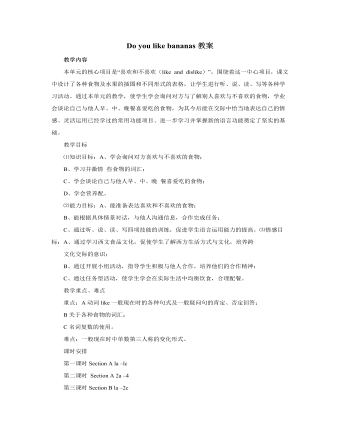
人教版新目标初中英语七年级上册Do you like bananas教案
教学目标 ⑴知识目标:A、学会询问对方喜欢与不喜欢的食物; B、学习并激情 些食物的词汇; C、学会谈论自己与他人早、中、晚 餐喜爱吃的食物; D、学会营养配。 ⑵能力目标:A、能准备表达喜欢和不喜欢的食物; B、能根据具体情景对话,与他人沟通信息,合作完成任务; C、通过听、说、读、写四项技能的训练,促进学生语言运用能力的提高。⑶情感目标:A、通过学习西文食品文化,促使学生了解西方生活方式与文化,培养跨 文化交际的意识; B、通过开展小组活动,指导学生积极与他人合作,培养他们的合作精神; C、通过任务型活动,使学生学会在实际生活中均衡饮食,合理配餐。 教学重点、难点 重点:A动词like一般现在时的各种句式及一般疑问句的肯定、否定回答; B关于各种食物的词汇; C名词复数的使用。 难点:一般现在时中单数第三人称的变化形式。
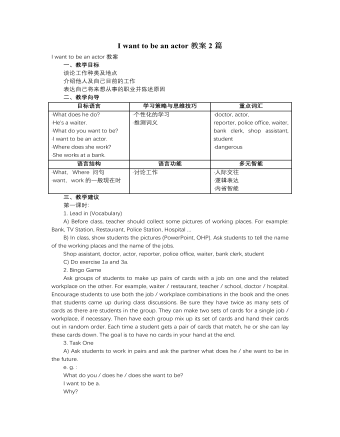
人教版新目标初中英语七年级下册I want to be an actor教案2篇
三、教学建议第一课时:1. Lead in (Vocabulary)A) Before class, teacher should collect some pictures of working places. For example: Bank, TV Station, Restaurant, Police Station, Hospital ...B) In class, show students the pictures (PowerPoint, OHP). Ask students to tell the name of the working places and the name of the jobs.Shop assistant, doctor, actor, reporter, police office, waiter, bank clerk, studentC) Do exercise 1a and 3a.2. Bingo GameAsk groups of students to make up pairs of cards with a job on one and the related workplace on the other. For example, waiter / restaurant, teacher / school, doctor / hospital. Encourage students to use both the job / workplace combinations in the book and the ones that students came up during class discussions. Be sure they have twice as many sets of cards as there are students in the group. They can make two sets of cards for a single job / workplace, if necessary. Then have each group mix up its set of cards and hand their cards out in random order. Each time a student gets a pair of cards that match, he or she can lay these cards down. The goal is to have no cards in your hand at the end.3. Task OneA) Ask students to work in pairs and ask the partner what does he / she want to be in the future.e. g. :What do you / does he / does she want to be?I want to be a.Why?Because it's (adj).B) Vocabulary: Section B, 1a4. Homework 1.2.
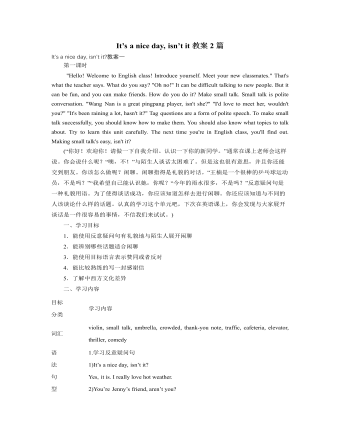
人教版新目标初中英语八年级下册It’s a nice day, isn’t it教案2篇
"Hello! Welcome to English class! Introduce yourself. Meet your new classmates." That's what the teacher says. What do you say? "Oh no!" It can be difficult talking to new people. But it can be fun, and you can make friends. How do you do it? Make small talk. Small talk is polite conversation. "Wang Nan is a great pingpang player, isn't she?" "I'd love to meet her, wouldn't you?" "It's been raining a lot, hasn't it?" Tag questions are a form of polite speech. To make small talk successfully, you should know how to make them. You should also know what topics to talk about. Try to learn this unit carefully. The next time you're in English class, you'll find out. Making small talk's easy, isn't it? (“你好!欢迎你!请做一下自我介绍。认识一下你的新同学。”通常在课上老师会这样说。你会说什么呢?“噢,不!”与陌生人谈话太困难了。但是这也很有意思,并且你还能交到朋友。你该怎么做呢?闲聊。闲聊指得是礼貌的对话。“王楠是一个很棒的乒乓球运动员,不是吗?”“我希望自己能认识她,你呢?“今年的雨水很多,不是吗?”反意疑问句是一种礼貌用语。为了使得谈话成功,你应该知道怎样去进行闲聊。你还应该知道与不同的人该谈论什么样的话题。认真的学习这个单元吧,下次在英语课上,你会发现与大家展开谈话是一件很容易的事情,不信我们来试试。)
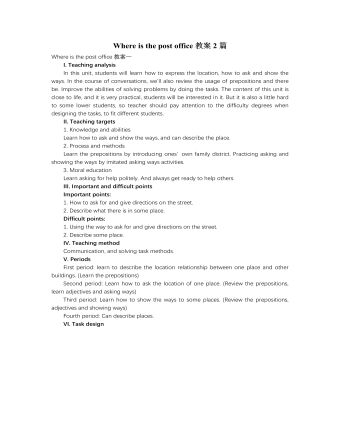
人教版新目标初中英语七年级下册Where is the post office教案2篇
Period 2 (3a----Section B 2c)Preview(Pre-task): Key points: What laAdd another information about their pen pals----their language on the cardnguage does she/he speak?She/He speaks....Does she/he have any brothers and sisters? Does she/he speak English?Preview(Pre-task): Add another information about their pen pals----their language on the cardKey points: What language does she/he speak?She/He speaks....Does she/he have any brothers and sisters? Does she/he speak English?Step 1 Revision1.Revisionand dictation of the new words 2.Revise the drills they learned yesterday.(by pairwork and grammar exercise)Step 2 Leading-inT has a conversation with one student. The conversation is following:---Do you have a pen pal?---Yes, I do.---What's your pen pal's name? ---His/Her name is....---Where is your pen pal from? ---He/She is from...---Where does he/she live? ---He/She lives in....---What language does he/she speak?He/She speaks...Write the new words on the Bb. They are following: EnglishChineseJapaneseFrenchStep 3 LearnLearn the new words with the whole class.Finish 3a with the students3b Pairwork T still does an example with one student Then the Ss practise in pairs. The example is following:--Curry Muray is my pen pal. He is from the United States.---What language does he speak?
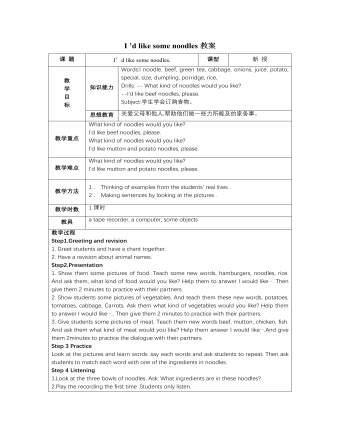
人教版新目标初中英语七年级下册I ’d like some noodles教案
教学过程Step 1: warming-up Sing a song---------“food and drink” Step 2: Revision1 Dictation2 Revise: What kind of noodles would you like?I’d like …What size bowl of noodles would you like?I’d like…Step 3: Presentation1 show pictures of food, ask students say the words.2 Students read the newspaper ad in 3a. Fill in blanks with words in the box. Then read the ad together, the teacher explains some difficult language points.3 Check the answers Step 4 PracticeAsk students to finish 3b in the same way according to 3a. Students read the short passage and fill in the blanks .At last, check the answers.Step 5 productionAsk students to write their own ad for dumplings, noodles, drinks, and other foods they know. Then ask students to read their partner’s ad. Then order food and drink from their partner.Step 6 Home workGroup work – make an ad about “food and drink”
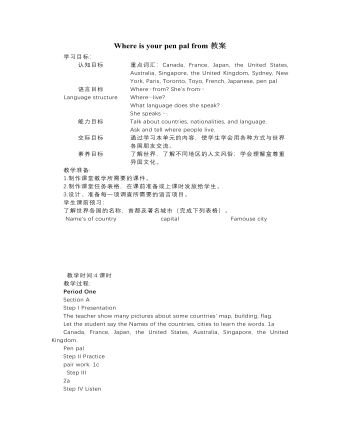
人教版新目标初中英语七年级下册Where is your pen pal from教案
2.1Match the country with the language.Step II Reading3a? let the students read the letter fast and answer the questions.? Let the students ask more questions about the letter as possible as the can.Step III Writing3b.Step IV. Pairwork2cStep V Listening2a, 2bStep V. HomeworkExercises book(1) P3Exercises book (2) P3Period FourStep I . Dictate the words and sentences in Unit1.Step II. Self-checkStep III. Check the answers for Exercises book in the unit.Step IV. Home workRevise and preparation for unit 2.教学反思:通过本单元的学习,学生基本可以谈论人们的国籍,居住城市及其所说的语言,通过书信方式去介绍自己并寻找笔友。但在涉及到国外的一些城市时,学生对这方面的知识相对欠缺,能介绍的城市并不多,也反应出学生课前预习不充分,这跟学生学习条件也有关,大多数学生无法通过网络获取所需信息。因此,在以后的教学中要多指导学生通过计算机网络获取信息,拓宽知识面。
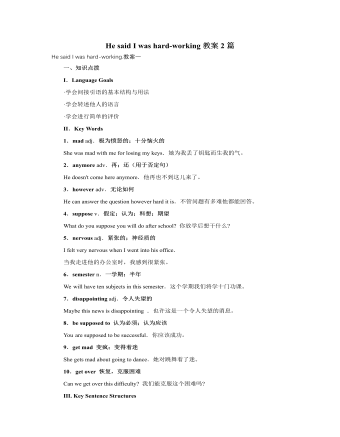
人教版新目标初中英语八年级下册He said I was hard-working教案2篇
This activity introduces some new vocabulary and provide oral practice using the target language.Task 1 . Ask four students to stand in front of the class, and the teacher asks them the following questions as a reporter.1.What are you going to do when you grow up?2.What are you going to do next week?3.What are going to do after school?The students will give different answers, then ask a good student to report what they said.I am going to e a doctor.What did she say?----------She said she was going to be a doctor.I am going to have a party on Friday night.What did he say?-------He said he was going to have a party on Friday night.I am going to do my homework.What did she say ?------ She said she was going to do her homework.I am going home after school.What did she say?-----She said she was going home after school.Say In this unit we are going to learn to use words like to report what someone said.Task 2. Read the instructions. Then ask a student to read the four questions. And write the words on the Bb. Explain what soap opera is.Task 3. Ask the students to Look at the pictures, point out the TV screens in the picture. Ask one girl to read what Marcia said.What did Marcia say? She said She said she was having a surprise party for Lana on Friday night. Repeat the other pictures in the same way.Activity3. Listen and number the pictures in activity 1a.
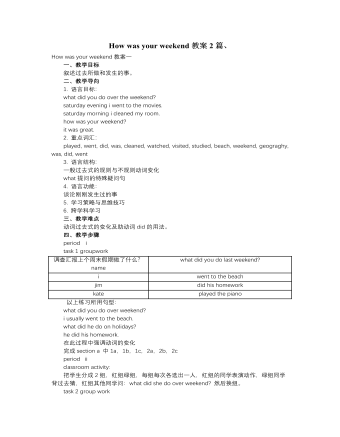
人教版新目标初中英语七年级下册How was your weekend教案2篇
Teaching Goal:1. General aims:Talk about recent past events2. Particular aims:A. Language Focus.Talk about recent past events and think of the past events.B. Language goalsHow was….?It was …What did …do over the weekend?C. Language structures:(1). How was your weekend? I was great. Pay attention to no form.(2). What did you do over the weekend? I played soccer. We went to the beach.D. Useful words and phrases:Words: was, did, went, beach, over, project, test, wasn’t, false, number, geography, spend, week, most, mixture, their, had, little, cook, read, saw, change, everyone, sit, sat, no, anythingPhrases: did one’s homework, played soccer, cleaned my room, went to the beach, played tennis, went to the movies, on Saturday morning, over the weekend, cook … for, what about, do some reading, have a party, talk show, go shoppingE. Grammar language:Present simple past tenseRegular and irregular verbsF. Learning strategies:Tour and holidaysG. Interdiscipinary:H. Emotion and manner:Teaching time: 5 periodsTeaching procedures:Period One教学步骤、时间 教师活动 学生活动 媒体应用Step 1Free talk 3’ Ask some questions like:Who’s on duty today?What’s the weather like? Answer and talk about something.让同学们回答下列问题1. Do you like weekend? (Let some students answer)It takes them three minutes to talk about the question.2. Why do you like weekend? (let the students answer) Most of the students like the weekend此时教师用汉语问:“在周末期间问你干了什么?这句话用英语这么回答?Let the students guess.At last the teacher give them right answer3. What did you do over the weekend?(板书、学习)
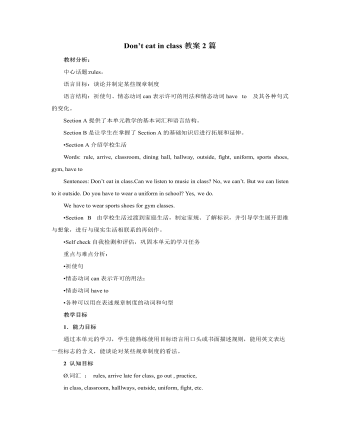
人教版新目标初中英语七年级下册Don’t eat in class教案2篇
Don’t fight. =You can’t fight. (板书,教读)教师把这些句子板书在黑板上,并请学生大声整齐地读祈使句和“can’t”句型,并让学生注意两种句型表达形式的不同和转换,“Don’t …=You can’t…”;并对学生说:These are our school rules. (板书,教读) You can’t break the school rules. Don’t break the school rules.(板书,教读)步骤3 :Practicea. T: Now, each of the students is breaking one of these rules.Please finish 1a.学生看图,完成1a的内容,检查答案并大声朗读校规。b. 听录音,完成1b,选出四位学生都违反了哪条校规;听之前,学生要读会英文名。c. 请两位学生朗读1c部分的句型;要求学生两人一组对话表演,SA扮演外校转来新生,SB告知本校校规。(学生可经过讨论,多说出他们想到的校规,不必只限于书上;教师应给予帮助)2) 第二课时(2a~4)步骤1 :warming up of revisionT: What are the rules at your school?学生使用“can”或祈使句表达各条校规;其中老师可引出“eat in the cafeteria outside”的表达。步骤2 :Practicea.T: Christina is an exchange student. She doesn’t know the rules. Let’s listen, what activities they’re talking about?学生听第一遍时,完成2a;第二遍时,完成2b;b. 请学生领读2c部分,看着2a完成的表格,理解2c活动的要求;分成小组针对2a进行问答;
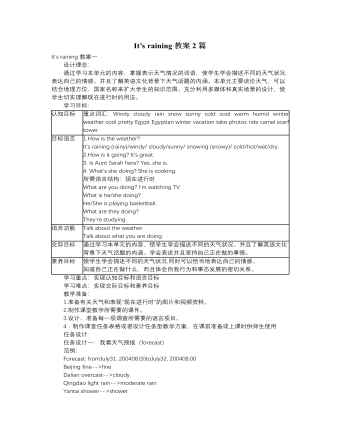
人教版新目标初中英语七年级下册It’s raining教案2篇
1 Each group choose one place to describe and what you are doing in it Choose one place, and describe what they are doing 2 Move around the room and give suggestions Talk about it and write it down 3 Ask one to show their works and act it Choose one of each group to make a report 4 Evaluate the best group and the best reporter Choose the best one Homework Ask your friends their ideal place and write about it教学反思:新课程标准中强调学生在课堂中的主体地位,在综合课中他们的主体地位就更加突出。在各个活动中给不同程度的学生不同层次的任务,让各层面的学生都有表现发挥的机会,从而产生对英语的兴趣。使用照片图片多媒体来辅助教学,效果更好。同时让了解其他国家风景,风俗的同学介绍ideal place,增加学生的背景知知识,实现跨学科交流的目的。教案点评:采用任务型教学模式,在各个活动中给不同程度的学生不同层次的任务,让各层面的学生都有表现发挥的机会,从而产生对英语的兴趣。使用照片图片多媒体来辅助教学,效果更好。让了解其他国家风景,风俗的同学介绍ideal place,增加学生的背景知识,实现跨学科交流的目的。
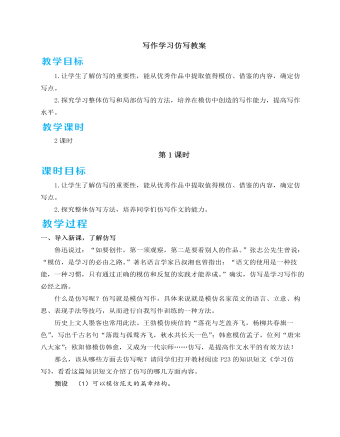
人教部编版语文八年级下册写作学习仿写教案
3.教师小结(1)仿写点分析。要认真分析、研究片段中的精彩之处,力求准确把握仿文的“外形”和“神韵”。 (2)仿写内容选择。选择自己熟悉的、有情感体验的内容,切不可为了“仿”而机械模仿甚至抄袭。(3)变通与创新。 分析名家名作的语言特点、写法规律,以“仿写”为阶梯、桥梁,达到写作的新高度、新领域。【设计意图】学生在阅读教学和句式仿写训练中对修辞手法、描写手法和表达方式等知识接触较多,如《社戏》教学中对心理描写手法的分析,《安塞腰鼓》课后布置的修辞手法的仿写训练,学生对此已有亲和感。本环节的主要目的在于让学生在实践中对仿写点的分析、仿写内容的选择、仿写的变通与创新产生切身的体悟。三、总结存储1.课堂小结学会根据需要恰当选择具体的、合理的仿写点,达到以“他山之石”来“攻玉”,“假名家之手”写“我心”的目的,是仿写的真正要义。2.实践演练完成课本P24“写作实践”第三题。
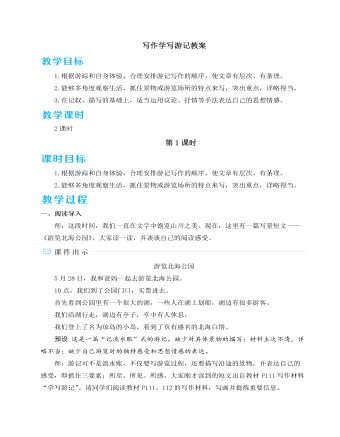
人教部编版语文八年级下册写作学写游记教案
4.组织材料师:一篇游记作品,既要有“灵魂”“血肉”,还得有“筋骨”——材料安排。请大家运用我们上节课学习的方法来组织材料。方法:(1)按照自己的游踪或独特体验,安排写作顺序。(2)能突出参观场所特征的要详写,其余的略写或不写。(3)丰富文章内容:适当加入叙事,引入一些典故、传说、史料、评价或诗文名句。示例:(1)写作顺序:以作者的参观路线为线索。(2)详略安排:详写鲁迅先生北京故居的工作室兼卧室,以突出鲁迅简朴、惜时的品质和忘我工作的精神品质;详写陈列大厅是为了赞扬先生的民族精神。其余的略写。(3)引入内容:引用古诗句“望崦嵫而勿迫,恐鹈之先鸣”,表现先生惜时的品质。(生交流,师点评)预设 (1)写作顺序:一楼的青铜器—二楼的陶器—三楼的古代画作。
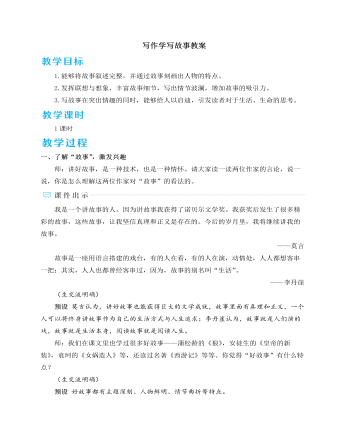
人教部编版语文八年级下册写作学写故事教案
师小结:《投诉母亲》中,“我”想让母亲辞职享清福,尽人子之孝心。没料到通往目标的路上障碍重重,解决一个障碍,又有一个新的障碍横在眼前,就这样一个个障碍将故事的矛盾冲突推向高潮。从让母亲辞职到放弃计划,顺从母亲,让故事有了戏剧性的收尾。这是运用了巧设障碍法让情节跌宕起伏。《错误的手套》中,母亲说“给孩子买副手套”,本意是让父亲给小外孙买手套,父亲却给女儿买了副手套,作者巧用语言的模糊性,使故事一波三折、情真意切。这是运用了巧设误会法让情节跌宕起伏。技法3:用巧设障碍法、巧设误会法写“情节曲折的故事”。4.归纳整合,明确技法师:共赏“好故事”,我们发现了三个技法。技法1:用“以小见大”的手法写“主题深刻的故事”。技法2:用对比手法写“人物鲜明的故事”。(1)通过人物在不同情境中的对比来突出人物性格特点。(2)通过人物之间的差异对比来突出人物特征。技法3:用巧设障碍法、巧设误会法写“情节曲折的故事”。
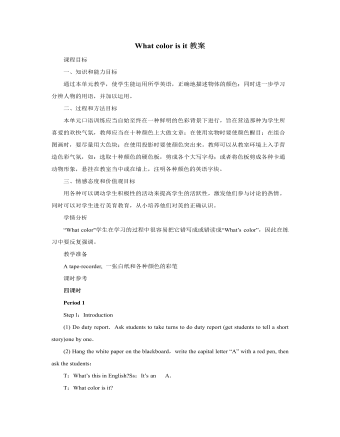
人教版新目标初中英语七年级上册What color is it教案
一、知识和能力目标通过本单元教学,使学生能运用所学英语,正确地描述物体的颜色;同时进一步学习分辨人物的用语,并加以运用。二、过程和方法目标本单元口语训练应当自始至终在一种鲜明的色彩背景下进行,旨在营造那种为学生所喜爱的欢快气氛,教师应当在十种颜色上大做文章;在使用实物时要使颜色醒目;在组合图画时,要尽量用大色块;在使用投影时要使颜色突出来。教师可以从教室环境上入手营造色彩气氛,如:选取十种颜色的硬色板,剪成各个大写字母;或者将色板剪成各种卡通动物形象,悬挂在教室当中或在墙上,注明各种颜色的英语字块。三、情感态度和价值观目标用各种可以调动学生积极性的活动来提高学生的活跃性,激发他们参与讨论的热情。同时可以对学生进行美育教育,从小培养他们对美的正确认识。
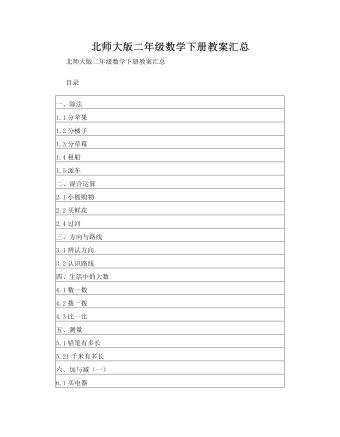
二年级数学下册教案汇总
教学反思:1、引导学生体验抽象除法竖式的过程。学生在学习表内乘除法时,利用乘法口诀已经能够在算式上直接写出得数。教材安排了“18个苹果,每盘放6个,可以放几盘”的“分苹果”活动,列举了四种解决这一问题的方法。在此基础上,引导学生按照自己的想法来分这些苹果,进而再由对除法竖式有一定了解的学生介绍竖式计算,并且把竖式中的每一步所表示的含义和分苹果的活动紧密联系起来。2、在探究中理解除法的试商方法。学生通过实际操作、观察比较,培养学生质疑和创新精神,学会学习、积累数学活动经验的有意义的学习过程。3、不足:这节课上得不够生动、活泼。
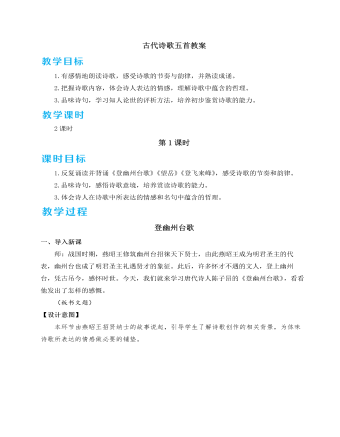
人教部编版七年级下册古代诗歌五首教案
师小结:《己亥杂诗》(其五)抒发了诗人离京南返的无尽愁绪,也表达出诗人虽已辞官,仍决心为国效力、奉献终生的决心,以及对国家民族的那份执着挚爱之情。全诗寄情于物,形象贴切,浑然一体,感人至深。【设计意图】本环节运用知人论世的方法,巧妙地将诗歌和写作背景糅合在一起,让学生逐步深入地理解诗人的情感和志趣。五、总结存储1.教师总结。本课学习了两首诗,让我们又获得了新的教益。《游山西村》中的名句“山重水复疑无路,柳暗花明又一村”让我们明白了在困境中坚持下去,也许会出现令人豁然开朗的转变,世间事物是消长变化的。《己亥杂诗》(其五)中的名句“落红不是无情物,化作春泥更护花”让我们感受到作者的爱国忧民、无私奉献精神。希望同学们能热爱传统文化,热爱古代的诗歌艺术,让这些经典文化伴你们健康成长。2.布置作业。(1)背诵并用楷书工整、规范地默写这两首诗。(2)选择感受最深的一首,发挥想象,写成一篇文章。(500字左右)。
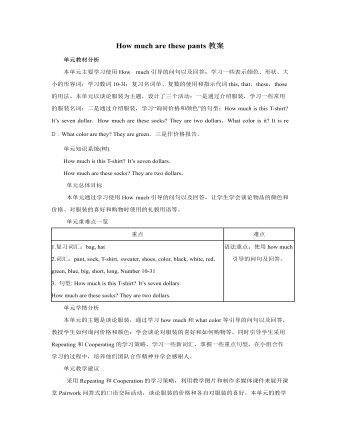
人教版新目标初中英语七年级上册How much are these pants教案
个性练习设计 阅读广告:在日常生活中,人们去买东西之前,一般要阅读广告,从广告中获取该商品的一些有用信息,包括价格、性能等。所以给学生提供有些商品的广告或让学生去商店去阅读一些商品的广告,从中获取商品的价格,即可以锻炼学生的阅读能力,又能提高实践能力。 Self Check 教学内容 Self Check(教材P42) 教学目标 知识与能力 复习词汇pant,sock,T-shirt,sweater,shoes,color,black,white,red,green,blue,big,short,long,数字10--31; 学习词汇Zig Zag,clothes,shop,yellow,ask,which;学会谈论服装的价格、颜色、大小和长短;学会填写价格标签。 过程与方法 运用Summarizing和Classifying的学习策略。在复习教学中,运用听写、绘画、互相询问调查与检测等手段,促使学生不断地使用所学内容,从而提高他们灵活运用知识的能力。 情感态度价值观 该部分学习内容主要是复习谈论服装的价格和颜色以及对服装的喜好,能引起学生的共鸣;通过购物的对话练习教学生学会购物时使用的礼貌用语和如何感谢人。
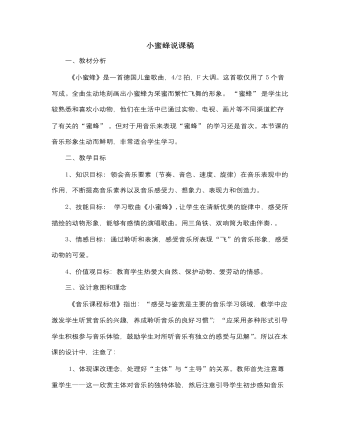
人音版小学音乐二年级下册小蜜蜂说课稿
出示课件,在茂密的大森林里,有一只小蜜蜂讲述它的故事——既歌曲的歌词。在演唱歌曲时把学生带入童话的世界里,学生乐学的氛围立即呈现。学习效果会事半功倍。唱的会更加感情充沛。因为有了具体的形象和感情基础,会让学生情不自禁的进入角色的。唱歌词的时候,用慢速指导学生唱好八分音符的小节,同时对“飞回蜂房”四个字的演唱要即使强调和纠正。在唱好歌曲的基础上,教师指导学生用唱名唱谱。这样既降低了唱谱的难度,又会达到很好的效果。3小组合作,激发创造力。本课的教育对象是小学二年级的学生,他们以形象思维为主,好奇、好动、模仿力强。能用打击乐器奏出强弱、长短不同的音。教师再次播放乐曲伴奏,和学生一起表演蜜蜂劳动的情景。之后教师拿出打击乐器。让学生分别判断出各打击乐器的声音特点,再分组合作练习为歌曲配伴奏。教师做适当的指导。小组派代表给大家展示编配的结果。其他学生做演唱,再给予适当的评价。
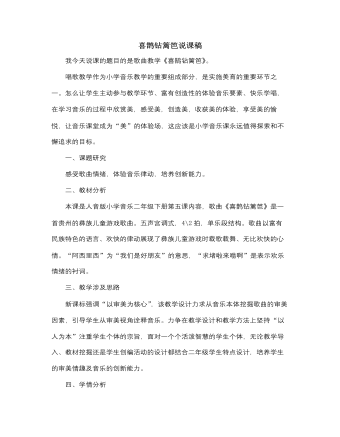
人音版小学音乐二年级下册喜鹊钻篱笆说课稿
5完整演唱歌曲。6、歌曲处理(讲解演唱技巧:自然大方、吐字清晰、富有感情、气息流畅、强弱力度的变化,还要有表情。)师:同学们!你们做游戏时的心情如何?注意“求堵啦来 求堵啦来 嗡啊嗡啊”表现了彝族小朋友召唤朋友来做游戏时的欢快的心情,大家应该唱得欢快些。现在,让我们把自己想象成那群少年,体会一下愉悦的心情,然后带着这种心情再把这首歌演唱一遍。三、拓展部分—— 学彝族基本舞蹈动作师:咱们中国的少数民族个个能歌善舞,彝族也不例外,我们一起来跳跳彝族的舞蹈怎么样?1讲解示范动作2生学跳3跟音乐跳4边唱边跳(有表情的演唱歌曲并随音乐舞蹈)师:请每一个同学都动起来、唱起来吧!四、结束语:师:音乐是人们了解一个民族文化的窗口。通过今天的学习,希望同学都能热爱我们的少数民族,更加喜爱我们的少数民族音乐。请同学们回去后把这首好听的歌曲唱给家人或朋友听,让我们把快乐传递给身边的每一个人,好不好?(好)

人音版小学音乐二年级下册郊游说课稿
1、听音乐熟悉旋律,整体感受歌曲。2放音乐,学生跟着老师原地按节奏踏步。有没有我们比较熟悉的乐句?3、你从刚才的歌曲中都听到了些什么内容?(教师大屏幕出示本课歌词。老师用响板把节奏打出来,学生朗读,注意读出强和弱。)4、老师发现同学们都等的不耐烦了,那就让我们随着音乐小声的唱起来吧,注意找一找有没有我们熟悉的地方?大家能不能一起唱唱?(老师弹琴,学生歌唱,注意唱的要优美。)5、歌曲处理教师启发:现在这首歌曲大家都比较熟悉,都会唱了,但是我们还是要应该把它唱得更好,你觉得怎样才能唱得更好听呢!(强弱、欢快的情绪,一、三句节奏比较紧凑,表现了小朋友们去郊游的高兴心情。第二句节奏比较舒展,表现了美丽的大自然景色。)在学生演唱歌曲的第二部分时,指导学生提前做好准备吸气,但是不要夸张的动作。慢慢吐气去唱好歌曲中的长音。注意保持气息声音不要抖。)





















